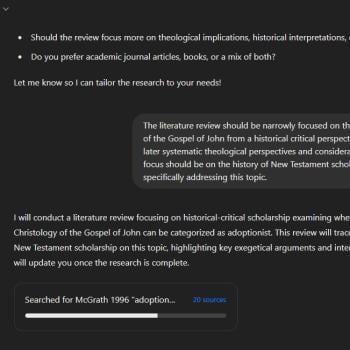Yesterday Jim West shared a linkto an article which ties in directly to the question I have been exploring in a couple of recent posts. The article is “THE “SPRING OF THE YEAR” (2 CHRONICLES 36:10) AND THE CHRONICLER’S SOURCES” by Michael Avioz, published in the Journal of Hebrew Scriptures. In this particular instance, Chronicles provides information about the timing of events which is not mentioned in Kings and which is confirmed by a Babylonian source.
When a text gets a detail right which is not in a source that author is known to have used, particularly if it is a detail that is unlikely simply to have been remembered and passed on orally, it becomes more likely that this reflects additional information was available to the author in another written source.
 In the case of the Gospel of John, it has always intrigued me that the author makes mention of 46 years spent building the temple (2:20). If Herod began building the temple in 19 BCE, or at least announced the restoration project then, that would place the conversation in John 2 around the year 27 CE – which is when we would expect the start of a roughly three-year public activity, as John alone indicates, to begin, if the crucifixion is dated to the year 30 or so. Could this be a fluke, and if so, is it not an impressive one? Is it not more likely that the Gospel of John’s author, whether or not he knew the Synoptics, also had some other source? Or can we envisage an author writing in the late first century making a good independent stab at when Herod’s project had begun and how it related to the chronology of Jesus’ life as it was coming together in a variety of sources? The latter is not impossible – but is it more likely than that the author of John had access to a written source that helped provide key details?
In the case of the Gospel of John, it has always intrigued me that the author makes mention of 46 years spent building the temple (2:20). If Herod began building the temple in 19 BCE, or at least announced the restoration project then, that would place the conversation in John 2 around the year 27 CE – which is when we would expect the start of a roughly three-year public activity, as John alone indicates, to begin, if the crucifixion is dated to the year 30 or so. Could this be a fluke, and if so, is it not an impressive one? Is it not more likely that the Gospel of John’s author, whether or not he knew the Synoptics, also had some other source? Or can we envisage an author writing in the late first century making a good independent stab at when Herod’s project had begun and how it related to the chronology of Jesus’ life as it was coming together in a variety of sources? The latter is not impossible – but is it more likely than that the author of John had access to a written source that helped provide key details?
In some cases, we may not have independent confirmation of a particular detail. In those instances, we may doubt the historicity of the information provided. But can we still conclude in at least some instances that an independent source has been utilized? If so, under what circumstances?
 In the case of the Mandaean Book of John, the work indicates that John had a wife and children, and large numbers of disciples. It depicts Jesus wanting to become John’s disciple. It names John’s parents “Zechariah and Elizabeth” but uses different forms than those found in the Syriac New Testament. It presents John as speaking about matters of ritual purity as well as ethics. There are enough points of intersection with the New Testament to make it plausible, and perhaps probable, that someone who composed parts of it at some stage had knowledge of the New Testament. But that, for me, is not the most interesting question. The interesting question – which will be explored in more detail in my conference paper, which I will post here on the day I read it, it not sooner – is whether there is reason to conclude that there is also material which reflects traditions independent of the New Testament.
In the case of the Mandaean Book of John, the work indicates that John had a wife and children, and large numbers of disciples. It depicts Jesus wanting to become John’s disciple. It names John’s parents “Zechariah and Elizabeth” but uses different forms than those found in the Syriac New Testament. It presents John as speaking about matters of ritual purity as well as ethics. There are enough points of intersection with the New Testament to make it plausible, and perhaps probable, that someone who composed parts of it at some stage had knowledge of the New Testament. But that, for me, is not the most interesting question. The interesting question – which will be explored in more detail in my conference paper, which I will post here on the day I read it, it not sooner – is whether there is reason to conclude that there is also material which reflects traditions independent of the New Testament.
Let me conclude by mentioning that Martin Dibelius (mentioned in Gabriele Mayer’s dissertation on the Book of John; see also Dibelius, From Tradition to Gospel p.124) detected underlying Luke’s infancy account about John a unified source which was Jewish in outlook and not Christian. In the Mandaean Book of John, the same can be said – nothing related to Christianity appears in the account of portents preceding John’s birth, while Jewish terminology appears: the Torah (Uraita, a term also found in the Talmud), the temple, and the Merkavah, for instance. The actual details of the Mandaean and Lukan accounts of events preceding John’s birth only intersect or overlap rarely, and briefly. And yet both arguably reflect an account which genuinely focused on John the Baptist for his own sake, and not as forerunner to Jesus. And so, while it would by no means be justifiable to posit that the Mandaean version is “the original version” of the story or even a “more authentic” or “more primitive” one, might it not be reasonable to deduce that it is more likely that the Mandaean-Lukan overlaps are due to both stemming ultimately from a common source deriving from Baptist circles, than to posit that the Mandaean author used Luke’s account?












